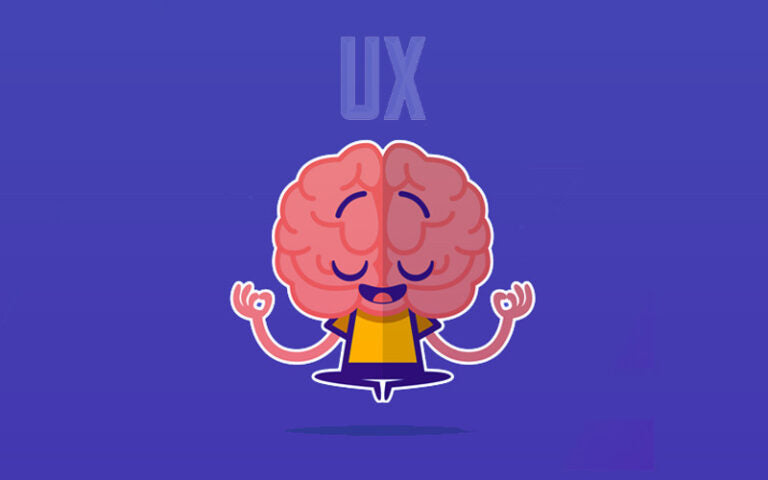
The Application of Cognitive Psychology to User-Interface Design
Blog AdminShare
Understanding how the human mind works is as important as understanding the technical aspects of interface design when building user interfaces. Cognitive psychology can provide essential insight into how users engage with an interface.
By applying cognitive psychology principles to your interfaces, you will be able to create successful solutions that are efficient, powerful, and engaging to your audiences.
Discover several cognitive components of UI design and learn techniques for using them to create better UX/UI experiences for your websites and applications.
If you are a web or graphic designer, you are probably always looking for ways to improve your workflows and create more efficient designs. Cognitive psychology can assist you in doing so by providing insights into how people interact with technology.
Let's look at some of the key concepts of cognitive psychology and how they can be applied to UI design to help you create interfaces that are more user-friendly and effective overall.
What Is Cognitive Psychology in UX Design?
Cognitive psychology is a branch of psychology that studies mental processes such as memory, problem-solving, and decision-making. It investigates how people think, learn, perceive, and remember information to better understand why humans behave in certain ways.
Cognitive psychology is an important part of UX design because it helps to understand how users process information they access via websites. It seeks to comprehend how humans think, remember, and learn.
UX designers put this knowledge to use by creating digital experiences that drive user engagement, keep users interested and informed during interactions with the site or platform, and provide the best possible experience for the user.
These considerations are applied through decisions such as information architecture and navigation flows, which can result in positive user reactions when done correctly.
When dealing with large volumes of information, you may need writing assistance. You may obtain one from writing services reviews websites such as Best Writers Online.
Cognitive Psychology Components

Here are the three components of cognitive psychology used in UI design:
#1. Expert Performance
Expert performance refers to when a user has become so familiar with an interface and ensures he can use it quickly and accurately without consciously thinking about what he is doing.
By incorporating expert performance techniques into UI design, developers can assist users in becoming proficient with their product by making it simple to learn and use.
It can be accomplished by making the navigation intuitive, displaying visual cues and feedback, and providing helpful instructions.
#2. Minimalist Designs
Minimalism is the idea of using as few elements on a page or interface as possible while still achieving the desired outcome. Minimalist designs can help create an interface that is easier to interpret and use, as it eliminates distractions and focuses the user's attention on what is important.
When creating minimalist designs, consider elements such as font size and color, whitespace, layout, imagery, and animation.
#3. Memory and Problem-Solving Considerations
Memory is key to a successful user experience, as it allows people to recall information quickly and accurately when needed. Problem-solving is also essential for users to be able to interact with an interface effectively.
Strategies for improving memory and problem-solving abilities include providing helpful instructions and tutorials, making sure the interface is consistent across different platforms, and offering feedback when mistakes are made.
Benefits of Applying Cognitive Psychology to UI Design

Applying cognitive psychology principles to user interface design can provide many benefits, including:
1. Improves the User Experience
Cognitive psychology can be applied to UI design to improve the user experience. By understanding how users think and process information, designers can create interfaces that are more intuitive and easier to use.
Additionally, cognitive psychology can help designers understand why users make certain errors, and how these errors can be avoided in future designs.
2. Helps Users Achieve Their Goals
Applying cognitive psychology to UI design can also help users achieve their goals. By understanding how users think and what they want to achieve, designers can create interfaces that are better able to guide users toward their goals.
Additionally, cognitive psychology can help designers understand why some users have difficulty achieving their goals, and how this difficulty can be overcome.
3. Reduces User Frustration
Another benefit of applying cognitive psychology to UI design is that it can reduce user frustration. By understanding the causes of user frustration, designers can avoid creating interfaces that are likely to cause frustration.
Additionally, cognitive psychology can help designers understand how user frustration can be reduced or eliminated.
4. Increases User Satisfaction
Applying cognitive psychology to UI design can also increase user satisfaction. By understanding what users want and need from an interface, designers can create interfaces that are more likely to meet or exceed user expectations.
Additionally, cognitive psychology can help designers understand how user satisfaction can be increased through the use of specific design elements.
5. Improves Usability
One of the most important benefits of applying cognitive psychology to UI design is that it improves usability. By understanding how users think and process information, designers can create interfaces that are easier for users to understand and use effectively.
Additionally, cognitive psychology can help designers identify potential usability problems before they occur and take steps to prevent them from happening in the first place.
6. Enhances Accessibility
Cognitive psychology can also be used to enhance accessibility. By understanding how users with disabilities think and process information, designers can create interfaces that are accessible to all users.
Additionally, it can help designers understand the needs of users with disabilities and how these needs can be met through user interface design.
7. Increases Efficiency
Applying cognitive psychology to UI design can increase efficiency. By understanding the processes that users go through when using a user interface, designers can create interfaces that are more efficient and require less effort from users.
Cognitive psychology can also help designers identify potential areas of efficiency in existing designs and make changes to improve them.
How User-Interface Designers Can Use Cognitive Psychology Principles to Create More Effective Interfaces?

When developing interface designs, user-interface designers can greatly benefit from cognitive psychology principles:
#1. Understand How the Brain Works
To design effective interfaces, user-interface designers must understand how the brain works. The brain is made up of many different regions, each of which is responsible for different functions.
For example, the prefrontal cortex is responsible for executive functions such as decision-making and planning, while the hippocampus is responsible for memory.
#2. Understand How People Process Information
It is also important to understand how people process information. The way that information is processed can vary depending on many factors, such as age, culture, and education level.
For example, younger adults are more likely to process information visually, while older adults are more likely to process information verbally.
Tailoring information to a specific group may be challenging at first. To overcome the issue while making the first steps, seek assistance from professional essay writers and writing services.
#3. Use Simple Language and Images
When designing interfaces, it is important to use simple language and images. This will help to ensure that users understand what they need to do to complete a task.
Additionally, using simple language and images will help to reduce cognitive load, which is the amount of information that a person can process at any given time.
#4. Use Familiar Concepts
When designing interfaces, it is also important to use familiar concepts. This will help users better understand how to use the interface and will also reduce cognitive load.
For example, if an interface is designed for a task that requires users to add two numbers together, it would be more effective to use the concept of addition rather than subtraction.
#5. Organize Information Logically

Another important aspect of interface design is logically organizing information. It will aid users in finding the information they need quickly and easily. For example, if an interface contains a list of items, it would be more effective to organize the items alphabetically rather than randomly.
#6. Use Consistent Design Elements
It is also important to use consistent design elements throughout an interface. This will help users better understand how to use the interface and will also make it easier to use.
For example, if all buttons on an interface are blue, users will know that they need to click on a button to act. However, if some buttons are blue and some are green, users may become confused about what they need to do to perform the needed action.
#7. Provide Feedback
Another important aspect of interface design is providing feedback. It will enable users to get to know whether or not they have completed a task correctly and will also help them to understand what they need to do next.
For example, if a user completes a task successfully, it would be helpful to provide positive feedback, such as a message that says, "Congratulations! You have completed the task."
However, if a user does not complete a task successfully, it would be helpful to provide negative feedback, such as a message that says, "Sorry, you have not completed the task."
#8. Allow Users to Customize Their Experience
Interface design should also allow users to customize their experience. It means allowing them to choose how they want to interact with the interface and what features they want access to.
For example, some users may prefer an interface that uses icons instead of text, while others may prefer an interface that uses text instead of icons. Users will be more likely to find the features they require quickly and easily if they can customize their experience.
#9. Try Out Different Interface Versions
Finally, it is critical to test different versions of an interface to ensure that it is user-friendly. This can include experimenting with different layouts, colors, fonts, and other design elements.
Designers can identify potential usability issues and make changes to ensure users have the best possible experience by testing different versions of the interface.
#10. Make Use of Accessibility Features
It is also important to include accessibility features when designing interfaces. This will ensure that users with disabilities can easily access and use the interface.
Text-to-speech functionality, screen reader support, keyboard navigation, and other accessibility features may be available. Designers can create an interface that is accessible to all users by using these features.
Examples of Well-Designed Interfaces That Consider Cognitive Psychology Principles

Now, it is time to look at some examples of well-designed interfaces considering cognitive psychology:
The Interface for the Amazon Kindle
The interface is designed to be simple and easy to use, with large buttons and clear text. The interface also makes it easy to find and purchase books, and manage your reading list.
The Interface for the Apple iPhone
The interface is designed to be intuitive and easy to use, with large icons and a simple layout. The interface also makes it easy to access the features of the phone. For example, the camera, music player, and email.
The Interface for the Google Search Engine
The interface is designed to be simple and easy to use, with a search bar that is easily visible and accessible. It also makes it easy to find relevant results and filter results by type.
The Interface for the Word Processing Program by Microsoft Word
The interface is designed to be familiar and easy to use, with a ribbon toolbar that provides quick access to all of the features of the program. The interface also makes it easy to format documents and insert pictures, tables, and shapes.
The Interface for the Adobe Photoshop Image Editing Program
It is another example of a well-designed interface that considers cognitive psychology. The interface is designed to be intuitive and easy to use, with large buttons and clear text.
The interface also makes it easy to edit images and create new ones from scratch.
The Interface for the Spotify Music Streaming Service
The interface is designed to be simple and easy to use, with large buttons and clear text. The interface also makes it easy to find and play music and create playlists.
Final Thoughts
Cognitive psychology findings can be used by user interface designers to create interfaces that are simple for users to understand and use. In this way, cognitive psychology can aid in making user experiences more efficient and enjoyable.
When creating interfaces, designers should consider their users' needs and how those users will interact with the interface. Designers can create better user experiences for everyone by taking these factors into account.
James Baxter is a professional ghostwriter, online marketer and blogger, who loves sharing his experience and knowledge with readers. His hobby is photography and travelling, so he has already been to 35 countries.


